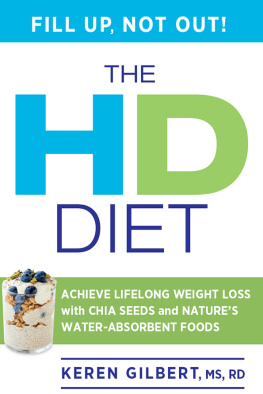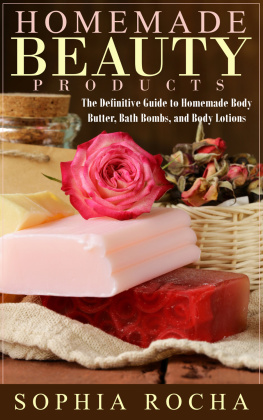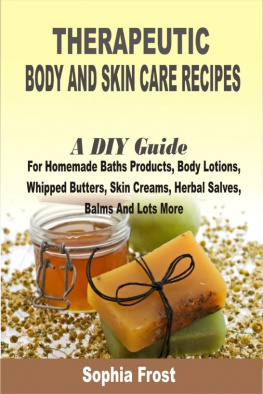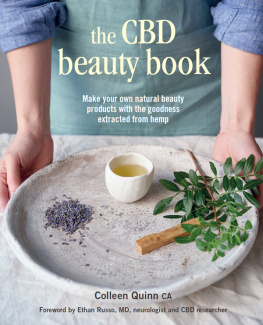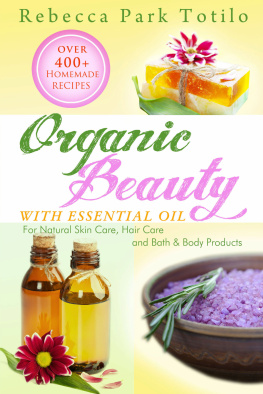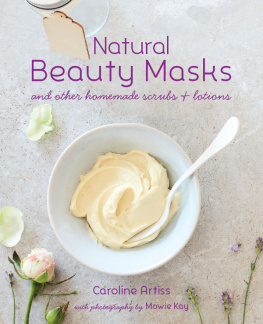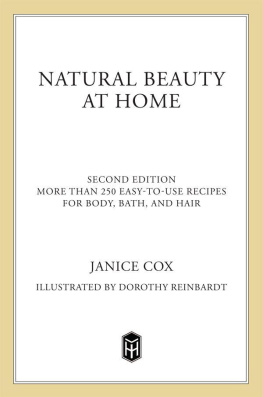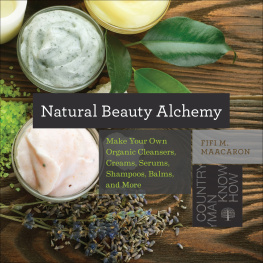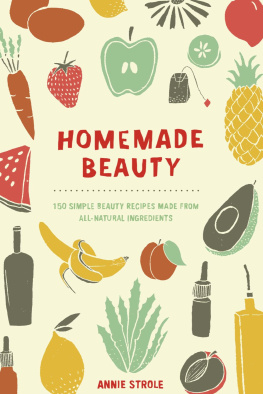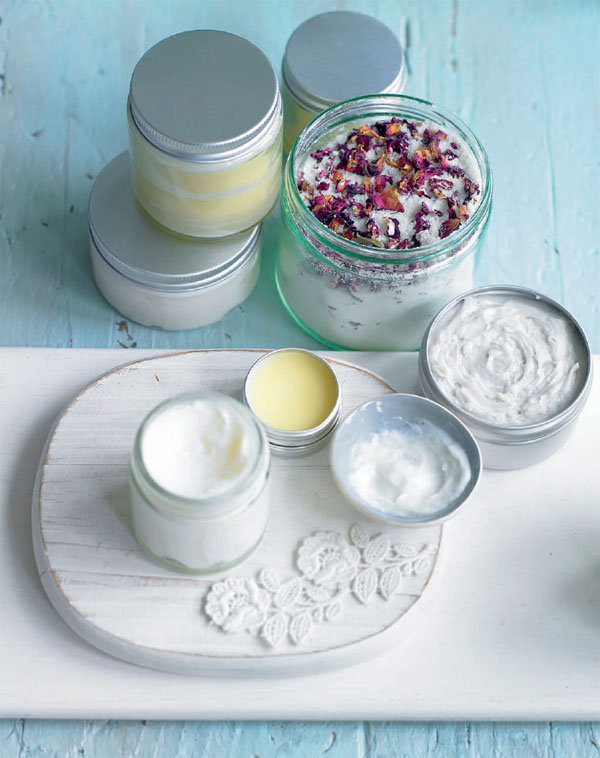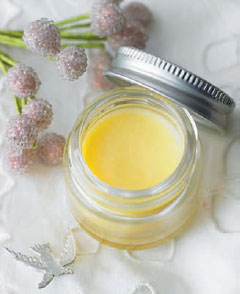
Natural Beauty
Natural Beauty
35 step-by-step projects for homemade beauty
KAREN GILBERT

This edition published in 2013 by CICO Books
An imprint of Ryland Peters & Small Ltd
2021 Jockeys Fields
London WC1R 4BW
519 Broadway, 5th Floor
New York, NY 10012
First published in 2011 under the title A Green Guide to Natural Beauty
www.rylandpeters.com
10 9 8 7 6 5 4 3 2 1
Text Karen Gilbert 2011
Design and photography CICO Books 2011
The authors moral rights have been asserted. All rights reserved. No part of this publication may be reproduced, stored in a retrieval system, or transmitted in any form or by any means, electronic, mechanical, photocopying, or otherwise, without the prior permission of the publisher.
A CIP catalog record for this book is available from the Library of Congress and the British Library.
eISBN: 978 1 78249 298 6
ISBN 978 1 78249 035 7
Printed in China
Copy editor: Alison Bolus
Designer: Louise Leffler
Photographer: Stuart West
Stylist: Sania Pell
Authors acknowledgments
Thanks to the team at CICO Books, Cindy Richards for asking me to write this book in the first place, and Gillian and Alison for their tireless editing. Special thanks to Stuart West and Sania Pell for making the recipes look so beautifulit was great working with you both!
Thanks to my fabulous friends at TCE for all your encouragement and inspiration, especially Bianca Tait whose excellent coaching skills helped me to remember how much I love teaching and sharing my knowledge with others.
To Romy for believing in me all those years ago, and to Richie for holding the fort while I took time out to write and for getting up at the crack of dawn to dig the car out of the snow so I could get to the photo shoot on time.
Disclaimer
The author and publisher have made every effort to ensure the accuracy of information in this book and assume no responsibility for errors, omissions, inaccuracies, or inconsistencies. The safe and proper use of the recipes and ingredients is the sole responsibility of the person using them. The author and publisher are not responsible for any misuse, nor are they responsible for any allergic reaction. The advice in this book should not be interpreted as medical adviceany health concerns the user may have should be addressed by a professional medical practitioner.
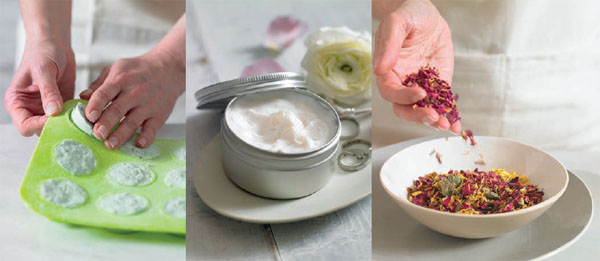
Contents
Foreword
by Romy Fraser ,
founder of Neals Yard Remedies



After working in the skincare industry for so many years, I sometimes forget that most people do not realize how easy it is to make beauty products at home. There is something I find very therapeutic about hand crafting a product from scratchjust like creating a meal from fresh ingredients, it does take a little bit more time and knowledge than grabbing something off the shelf, but the results are worth it. In writing this book I wanted to create something that could be used both by a complete beginner to make products for fun as well as giving those with a bit of experience some great recipes to try.
The workshops I teach are generally attended by women (and the occasional man) as both a way to learn a new skill and as a social event. Most of the recipes in this book make one bottle or jar of product, but there is no reason why you cant get a group of friends together and make a batch of products. Make it a fun occasion and get creative.
What is natural and is it always best?
My answer is always the samejust because its natural, it doesnt make it safe and just because its man made, that doesnt make it harmful. Most ingredients used in skincare are processed in some way to make them usable. Essential oils are steam distilled and oils are pressed by machine. Look for botanical ingredients that have the least amount of processing and are as close to their natural source as possible, and do not be afraid to use a small amount of safe synthetics to make certain products more functional.
The term green means different things to each of us depending on our lifestyle. For some it just means recycling and re-using carrier bags; for others it means composting, growing organic veg, and cycling everywhere. When making skincare products, decide on your expectations for their performance and what compromises you are willing to make. For some, emulsifiers and preservatives may be out of the question, which restricts the types of products you can make. For others, you may be prepared to compromise 56% of the green-ness for a more sophisticated producteach view is equally valid.
Organic certification has become a huge focus for green skincare brands but I wonder if we have lost sight of some real issues here. Should we be shipping ingredients halfway across the world just because they are organic, and shun good local producers because they do not have organic certification? Should we buy organic over non-certified fair trade, or should we support fair trade co-ops regardless of their organic status? You will need to make up your own mind on what is important to you, and it will be different for everyone.
I hope you find the recipes both fun to make and fabulous to use. Feel free to experiment and if you come up with a great variation, do let me know!
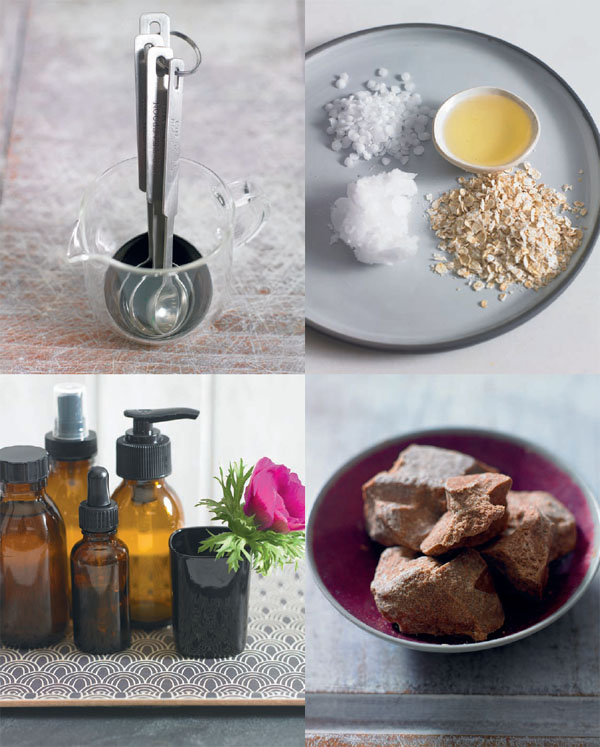
I know the temptation is to skip this chapter and move straight on to making the recipes that follow, but please take just a few moments to read through these pages. Youll find good advice on the equipment and different types of ingredients used in the recipes, plus some essential information on using preservatives and the shelf life of your creations. There are also guidelines on skincare and beauty from the inside out, and once youve mastered the basics, you will be able to create your own variations of my recipes.
The dermis
This layer is quite tough with a lot of elasticity since it is mainly composed of connective tissue made up of collagen and elastin. As we age, the collagen fiberswhich help to bind water to the skin and give it strengthdecline, and so wrinkles start to develop. If the skin is overstretched, as in cases of obesity and pregnancy, the elastin fibers can rupture, resulting in stretch marks. The dermis also contains hair follicles, sweat glands, sebaceous glands, blood and lymph vessels, and sensory nerve endings.
The sebaceous glands are located near the hair follicles and are present in all parts of the body except the palms of the hands and soles of the feet. They secrete sebuma mixture of oils and fatsin order to keep the skin lubricated and to provide some waterproof protection. Sebum also acts as a bactericidal and antifungicidal agent to prevent microbes invading the skin. Sebaceous activity is regulated by the male sex hormone androgen, which is present in both men and women and increases at the onset of puberty; this is why oilier skin and acne are more common around that age, especially in teenage boys.





